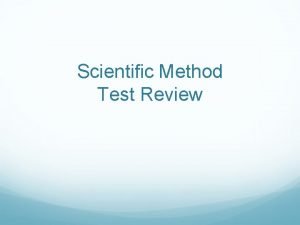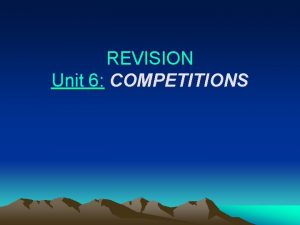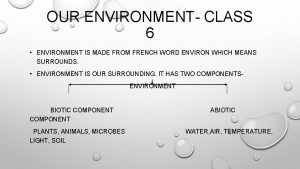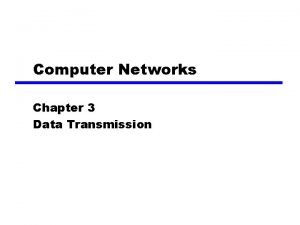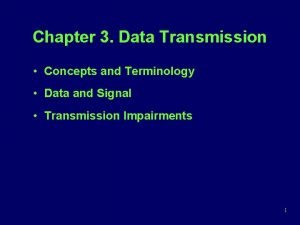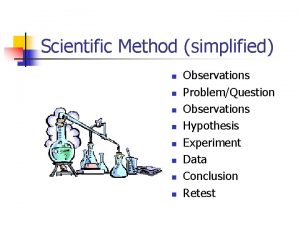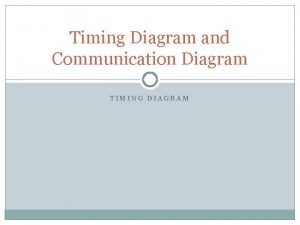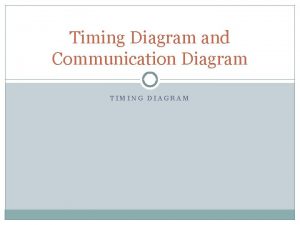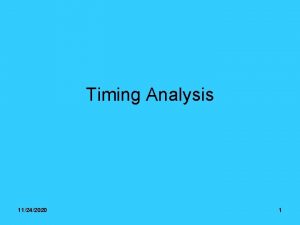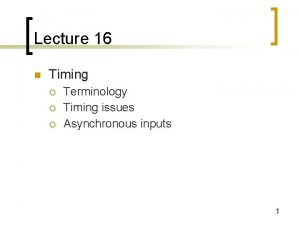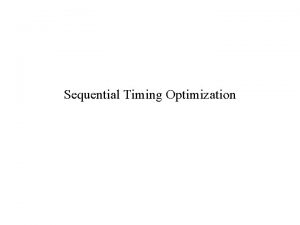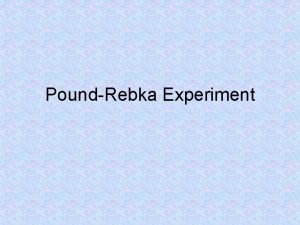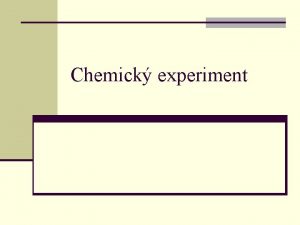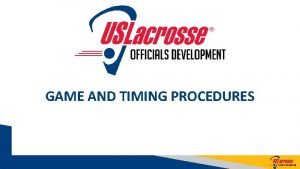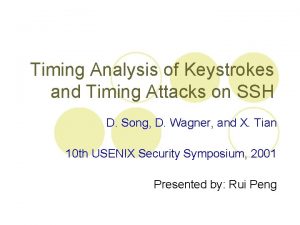Class Experiment Data and Terminology Timing Terminology Our












































- Slides: 44

Class Experiment Data and Terminology

Timing Terminology

Our Experiment: One Session: One set of functional and anatomical scans • e. g. , In patients, may have one session before treatment and one after

Protocol File Brain Voyager file type: . prt (protocol) Text file (can be edited by a text editor

GUI view Protocol File Text Editor view …

Protocol Terminology bodies faces hands scrambled black = baseline fixation 1 run Run: Continuous collection of data over time • typically 3 -10 minutes Condition: type of stimuli or task 5 conditions (or 4 conditions + baseline) Some terminology varies between labs e. g. , “scan” can mean run, volume or session

Protocol Terminology bodies faces hands scrambled black = baseline fixation 1 st epoch or block of faces Epoch: One block of trials for a condition Block Design: Experiment in which trials are grouped into blocks -- typically ~15 s/block (range 10 -30)

Protocol 1 st face epoch RUN TIME TRIALS Trial 1 800 -ms stimulus duration (SD) Trial 2 200 -ms intertrial interval (ITI) 1 -s stimulus onset asynchrony (SOA) Note for cognitive science sticklers: Because stimuli are unmasked and visual processing likely continues in iconic memory during the ITI (and because the HRF isn’t that great temporally anyway), our models will assume visual activation is high throughout the epoch and does not fluctuate between SD and ITI

Protocol Terminology 1 st trial of faces left

What happens at the scanner in a session?

f. MRI Experiment Stages 1) Prepare subject • Consent form • Safety screening • Instructions and practice trials if appropriate

f. MRI Experiment Stages 2) Sagittal scout images Note: That’s one g, two t’s Take images along the midline to plan slices In this example, these are the functional slices we want: 52 slices x 2. 5 mm

f. MRI Experiment Stages 3) Shimming • putting body in magnetic field makes it non-uniform • adjust 3 orthogonal weak magnets to make magnetic field as homogenous as possible in functionally scanned volume

f. MRI Experiment Stages 4) Take anatomical (T 1) images • high-resolution images (e. g. , 1 -mm resolution) • 3 D data: 3 spatial dimensions, sampled at one point in time Anonymous [defaced] 1 slice (sagittal) 2 D

1 1 mm m m 1 mm Zooming In

Anatomical (T 1) Scan Brain Voyager file type: . amr (anatomical MR) 3 D (stack of 2 D slices) Our data: 176 slices at 1 -mm isotropic resolution

One Volume = One stacked set of slices that forms a full 3 D sample of the desired brain volume + z L R + y - + x Brain Voyager file type: . vmr (volumetric MR) 3 D Our data: 176 slices at 1 -mm isotropic resolution

Left is what? !!! Neurologic (i. e. sensible) convention • left is left, right is right L R - + x=0 Radiologic (i. e. stupid) convention • left is right, right is left R L + x=0 Note: Make sure you know what your magnet and software doing before publishing left/right info!

Pro Tip Put a vitamin E capsule on the one side (always the same side!) of the subject’s head or coil.

f. MRI Experiment Stages 5) Take functional (T 2*) images • medium-resolution images (e. g. , 2. 5 -mm resolution) • 4 D data: 3 spatial dimensions x time dimension

Functional Activation Changes Over Time Flickering Checkerboard OFF (60 s) - ON (60 s) - OFF (60 s) - ON (60 s) Source: Kwong et al. , 1992

Functional Volume: One stacked set of slices that forms a full sample of the desired brain volume Brain Voyager file type: . fmr (functional MR) appears 3 D (stack) but you can see 4 th dimension (time) through movie Our data: 52 slices at 2. 5 -mm isotropic resolution and 1 -s temporal resolution

Volumes in Time 340 volumes We collected one volume every second for 340 s One can think of volumes as spatial (3 D units) or temporal (e. g, 1 volume = 1 s) … 340 volumes

Slice Terminology SLICE THICKNESS e. g. , 2. 5 mm IN-PLANE SLICE Field of View (FOV) e. g. , 21. 0 cm m m 5 2. 5 mm 2. In-plane resolution e. g. , 210 mm / 84 = 2. 5 mm VOXEL (Volumetric Pixel)

non-isotropic Voxel Size isotropic non-isotropic same size in 3 directions 3 x 3 x 6 = 54 mm 3 3 x 3 x 3 = 27 mm 3 2. 1 x 6 = 27 mm 3 e. g. , SNR = 100 e. g. , SNR = 71 In general, larger voxels buy you more SNR. EXCEPT when the activated region does not fill the voxel (partial voluming)

Explain voxel sizes clearly … especially if Jody will be your thesis examiner! • Anatomical voxel sizes are typically 1 -mm isotropic • Functional voxel sizes are typically 2 - to 3 -mm isotropic • Software may resample functional voxel sizes – e. g. , Brain Voyager resamples functional voxels to 1 -, 2 - or 3 mm isovoxel resolution • Thus a statement like, ”[Region X] comprised Y voxels” is unclear. • Pop quiz: Which of the following is correct for describing 3 -mm isovoxel resolution? A. Functional voxels were 3 mm 3. B. Functional voxels were (3 mm)3. C. A or B. They’re equivalent.

Volumetric Functional We can render the functional data in the same volumetric coordinate system as the anatomical This shows the first functional volume of the first localizer Brain Voyager file type: . vtc (volumetric time course) appears 3 D (stack) but you has 4 th dimension (time)

Thinking About Functional Data t 1 t 2 t 3 t 4 … t 340 Raw data • one run of our localizer • 52 slices x 84 • 366, 912 voxels • 2. 5 -mm isovoxel resolution • 340 volumes (time points) @ TR=1 5 min: 40 s/run • 52 x 84 x 340 = 124 M data points (value = signal intensity) Processed data • 4 dimensions • 3 spatial dimensions • x, y, z • 1 time dimension • One way to think about it • 340 volumes • Another way to think about it • 366, 912 time courses from Brain Voyager Documentation Functional data resampled to Native VTC with (2 mm)3 resolution and masked to exclude voxels outside the brain 194, 003 functional voxels x 340 time points

Resampling and Masking t 1 t 2 t 3 t 4 … t 340 Raw data (fmr) • one run of our localizer • 52 slices x 84 • 366, 912 voxels of (2. 5 mm)3 Resampled data (vtc) • resample data to (2 mm)3 resolution • exclude voxels outside the brain • 194, 003 functional voxels x 340 time points

Which ”voxel size”? • Native anatomical (slices) – 1 mm isotropic • Native functional (slices) – 2. 5 mm isotropic this is what matters most for data quality • Resampled anatomical (volumetric vmr) – 1 mm isotropic • Resampled anatomical (volumetric vtc) – 2 mm isotropic should be <= native resolution (but making this really small gives you huge files that take a long time to process) native = resolution collected from the scanner (unresampled)

Resampling • Data may have to be resampled – to go from slices to volumes • e. g. , Brain. Voyager offers vtc resolutions of (1 mm)3, (2 mm)3 or (3 mm) 3 – to get all participants in the same spatial coordinate system so you can do group stats – when correcting for head motion – when doing different filtering (e. g. , spatial smoothing) Example • resampling from 2. 5 -mm. fmr to create 2 -mm. vtc • • • white = 1 mm cubes for reference green = 2. 5 mm native func red = 2 mm resampled func • e. g. , highlighted red voxel can be derived from weighted combination of green voxels: (1 x lower left + 3 x lower right)/4

MRI vs. f. MRI high resolution (1 mm) MRI f. MRI low resolution (~2. 5 -3 mm) One 3 D volume … series of 3 D volumes (i. e. , 4 D data) (e. g. , every 2 sec for 5 mins)

Spot the Differences

T 1, T 2 and T 2* • • • T 1 = “tee one” = anatomical scan, normal contrast (GM darker than WM), typical anatomical for cogneuro expts T 2 = “tee two” = anatomical scan, reverse contrast (GM brighter than WM), used in clinical scan and animal scans because sometimes it can give better contrast between tissues (e. g. , tumor vs. normal tissue, GM vs. WM), susceptibility artifacts T 2* = “tee two star” = functional scan (usually EPI), reverse contrast (GM brighter than WM), susceptibility artifacts, sensitive to BOLD (which is a fine-scale susceptibility artifact) normal brain in T 1 vs. T 2 tumor in T 1 vs. T 2 normal brain in T 2*, showing susceptibility artifacts

Data Organization Image from Poldrack et al. , 2011 • Anatomical or functional data files are basically just matrices of intensity values • Matrices may be 2 D for single slices or 3 D for one volume or 4 D for series of volumes

Header Information • Headers • contain info about scanning parameters in structured format • may be separate from data (e. g. , SPM/Analyze uses separate. hdr and. img files) or combined with data (e. g. , BV. vmr file includes both header and data)

Working With Data • Different scanners and packages use different formats • Examples – – Siemens: DICOM format (Digital Imaging and Communications in Medicine) SPM: Analyze MNI: MINC Brain Voyager: vmr, vtc, etc. • NIf. TI (Neuroimaging Informatics Technology Initiative) – the new default for file formats – commonly used format useful for transferring data between software packages – other variants (e. g. , GIf. TI for surfaces) • Can often hack files (esp. text-only files) faster than modifying via GUIs

BIDS = Brain Imaging Data Structure

BIDS

Dummy scans or Disdaqs • Discarded data acquisitions: trashed volumes at the beginning of a run before the magnet has reached a steady state • The scanner may throw out the disdaqs before it saves the data or it may save them too, in which case you have to discard them in your software • Sometimes it can take awhile for the subject to reach a steady state too -Startle response!

Dummy Scans Two options for dealing with dummy scans 1. Discard them at the scanner 2. Discard them in your analysis software Example, for our localizer protocol we want 340 real (non-discarded) volumes (TR = 1 s). Say we decided to add 5 dummy scans. 1. Tell the MR technician to collect 345 volumes, count the first 5 as dummy scans and save only the last 340. In your software, do not skip any volumes. 2. Tell the MR technician to collect 345 volumes and save all of them. Tell your analysis software to skip the first 5.

Synchronizing your data collection and your stimulus/task software All of our stats depend on modelling when things happened. If your model is misaligned with the data, say by 5 s in the previous example, your estimates of activation will be incorrect.

Protocol • If this is your protocol, you want to be sure that the first body was presented 16 s in (not 11 s or 21 s if you don’t properly account for the 5 s of dummy scans)

Timing Strategies at CFMM • • • The scanner console emits one “trigger” at the start of each volume (i. e. , first slice), starting with the “real” (non-dummy) volumes (i. e. , no trigger is sent for dummy volumes) There is a trigger box that can plug into the USB port of your stimulus computer/laptop The trigger is read in as the equivalent to the letter “T” (letter configuration) or the number “ 5” (number configuration, where 5 is the number above the T key but not 5 on the number pad) • • The stimulus computer can count triggers to know when to present stimuli e. g. , presenting body #1 at the start of the 17 th real volume (i. e. , after 16 s), body #2 on the 18 th real volume (i. e. , after 17 s) and so on • You can also allow your software to be free running (e. g. , present body #1 16 s after the program starts) This is fine if both the stimulus computer and the scanner console have accurate timing but some people prefer to use triggers • • Trigger timing is one of the things most likely to go wrong in an f. MRI session so pilot test this carefully (in pilot time, when you’re not paying $150/h and you don’t have a participant getting bored in the scanner)
 Our awareness of ourselves and our environment
Our awareness of ourselves and our environment Awareness of ourselves and our environment is
Awareness of ourselves and our environment is Awareness of ourselves and our environment is
Awareness of ourselves and our environment is Awareness of ourselves and our environment
Awareness of ourselves and our environment Thinking affects our language which then affects our
Thinking affects our language which then affects our Our census our future
Our census our future Christ be our light
Christ be our light Our life is what our thoughts make it
Our life is what our thoughts make it We bow our hearts we bend our knees
We bow our hearts we bend our knees Our census our future
Our census our future Our life is what our thoughts make it
Our life is what our thoughts make it Money madness poem summary in english
Money madness poem summary in english God our father christ our brother
God our father christ our brother Our future is in our hands quotes
Our future is in our hands quotes Right hand rule positive charge
Right hand rule positive charge After the experiment scientists organize and the data
After the experiment scientists organize and the data Welcome to city guesser
Welcome to city guesser Welcome to the english class images
Welcome to the english class images Welcom to our class
Welcom to our class Can we have conversations
Can we have conversations Welcome to your english class
Welcome to your english class Welcome to our class
Welcome to our class Words with str
Words with str Easter happens around the same time as passover
Easter happens around the same time as passover Our earth class 2 ppt
Our earth class 2 ppt Our class won the competition
Our class won the competition Our environment class 6
Our environment class 6 Welcome to our class
Welcome to our class In our class today we
In our class today we Welcome to our class in chinese
Welcome to our class in chinese Our class won the competition
Our class won the competition Welcome to our class
Welcome to our class Welcome to our class
Welcome to our class Welcome english class
Welcome english class Welcome to our class
Welcome to our class ñ
ñ Data transmission concepts
Data transmission concepts Question hypothesis experiment data conclusion
Question hypothesis experiment data conclusion Question hypothesis experiment data conclusion
Question hypothesis experiment data conclusion Egg in vinegar experiment conclusion
Egg in vinegar experiment conclusion Introduction to ooad
Introduction to ooad Difference between abstract class and concrete class
Difference between abstract class and concrete class Therapeutic class and pharmacologic class
Therapeutic class and pharmacologic class Static and dynamic class loading in java
Static and dynamic class loading in java Timing and control in computer architecture
Timing and control in computer architecture















